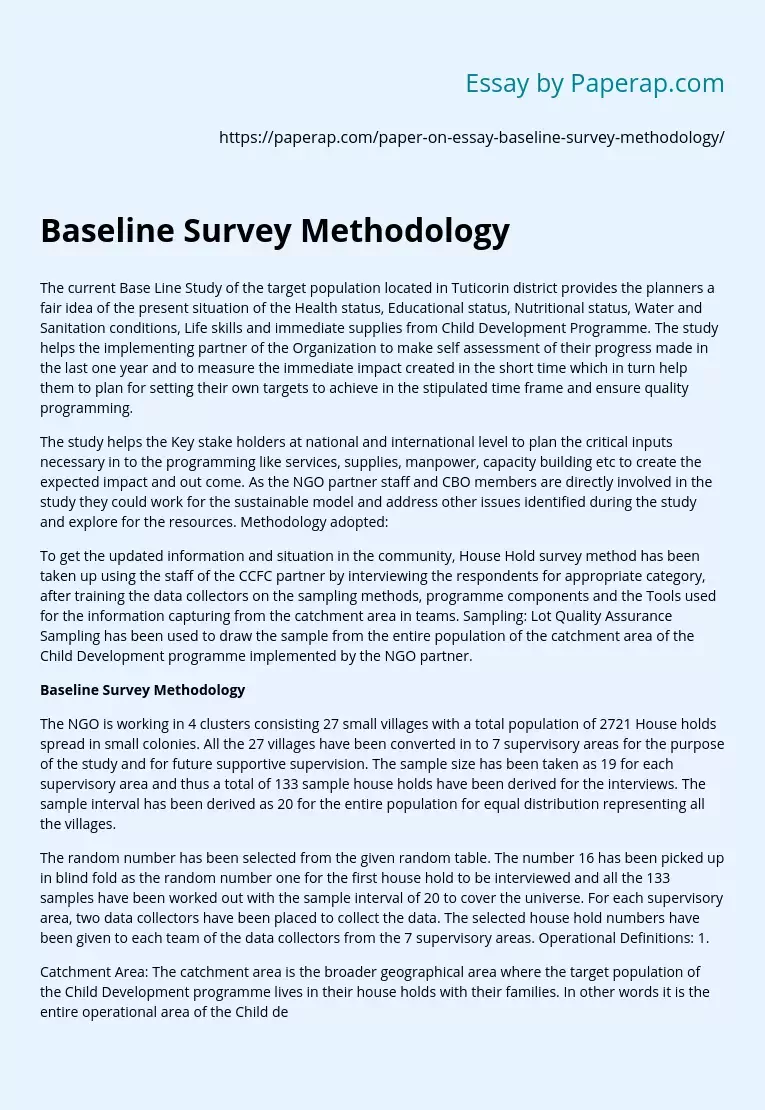Baseline Survey Methodology
The current Base Line Study of the target population located in Tuticorin district provides the planners a fair idea of the present situation of the Health status, Educational status, Nutritional status, Water and Sanitation conditions, Life skills and immediate supplies from Child Development Programme. The study helps the implementing partner of the Organization to make self assessment of their progress made in the last one year and to measure the immediate impact created in the short time which in turn help them to plan for setting their own targets to achieve in the stipulated time frame and ensure quality programming.
The study helps the Key stake holders at national and international level to plan the critical inputs necessary in to the programming like services, supplies, manpower, capacity building etc to create the expected impact and out come. As the NGO partner staff and CBO members are directly involved in the study they could work for the sustainable model and address other issues identified during the study and explore for the resources.
Methodology adopted:
To get the updated information and situation in the community, House Hold survey method has been taken up using the staff of the CCFC partner by interviewing the respondents for appropriate category, after training the data collectors on the sampling methods, programme components and the Tools used for the information capturing from the catchment area in teams. Sampling: Lot Quality Assurance Sampling has been used to draw the sample from the entire population of the catchment area of the Child Development programme implemented by the NGO partner.
Baseline Survey Methodology
The NGO is working in 4 clusters consisting 27 small villages with a total population of 2721 House holds spread in small colonies. All the 27 villages have been converted in to 7 supervisory areas for the purpose of the study and for future supportive supervision. The sample size has been taken as 19 for each supervisory area and thus a total of 133 sample house holds have been derived for the interviews. The sample interval has been derived as 20 for the entire population for equal distribution representing all the villages.
The random number has been selected from the given random table. The number 16 has been picked up in blind fold as the random number one for the first house hold to be interviewed and all the 133 samples have been worked out with the sample interval of 20 to cover the universe. For each supervisory area, two data collectors have been placed to collect the data. The selected house hold numbers have been given to each team of the data collectors from the 7 supervisory areas. Operational Definitions: 1.
Catchment Area: The catchment area is the broader geographical area where the target population of the Child Development programme lives in their house holds with their families. In other words it is the entire operational area of the Child development programme taken up by the partner NGO in the villages /communities. 2. Supervisory Area: It is the area where few villages /communities with the target population taken up for programme intervention and better support supervision by the programme staff.
Here the Supervisory Area has been used for the purpose of the study, other wise earlier the area was supervised by 4 staff in 4 clusters of villages. 3. Tool: In this study well structured questionnaires have been used for different categories of the target population for interviews in a schedule. Each interview schedule consists of 3 questionnaires to cover 6 categories of the population in their different life stages. The information provided by the respondents is recorded in appropriate boxes in codes in the questionnaire sheets.
The answers to some open ended questions are recorded in the space provided in the questionnaire. 4. Respondents: The respondents in this study are those who provide the information for the questions asked by the interviewers (Data Collectors). For the children of the age group 0 to 5 years, the mothers are the respondents, for the age group of 6 to14 years children the respondents are the children themselves and for the age group 15 to 24 years, the youth from the house hold are the respondents.
Baseline Survey Methodology. (2019, Dec 05). Retrieved from https://paperap.com/paper-on-essay-baseline-survey-methodology/

